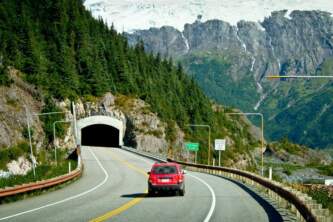Anchorage History
Gold Lures First Settlers
Alaska’s 1880 Census calculated that a mere 430 non-Natives had moved to Alaska in the decade after its purchase. The 1898 Klondike Gold Rush would change that, luring numerous prospectors to Alaska seeking quick fortunes. By 1910, 40,000 non-Natives had found their way north. Yet, even when the territory’s population had reached 65,000, the modern city of Anchorage you now see on the shores of Cook Inlet was nothing more than wilderness.
Railroad Births A Town
Anchorage’s development began in 1915, when Congress authorized construction of the only federally owned railroad in the nation’s history. It would run from tidewater to Alaska’s Interior, passing the coal deposits of the Matanuska Valley. Construction headquarters was at the mouth of Ship Creek in present-day Anchorage. Overnight, a tent city sprang up as thousands of laborers flocked north to take advantage of the lucrative employment opportunities. You can see Anchorage's first house, built in 1915, at 420 M Street, and one of its first concrete buildings at 4th and G–still owned by the family that built it.
Anchorage’s non-Native population grew in the 1920’s and became more stable as laborer families established homes here. In 1935, an unusual New Deal program was extended to Alaska. Two hundred three families from economically depressed counties in Minnesota, Wisconsin, and Michigan were offered a chance to create a new agricultural community in Matanuska Valley, so chosen because it was thought they could survive the cold Northern winters. Many returned home, but today you can see the descendant farms of those who remained.
World War II Changes Alaska Forever
In 1939, a quarter century after its founding, Anchorage’s population stood at a sleepy 4,229. But after Japan’s attack on Pearl Harbor, the military poured $3 billion in facilities and 300,000 military personnel into Alaska. Two bases, Elmendorf and Fort Richardson, were established near Anchorage. In just ten years, the population swelled sevenfold to 30,000, making Anchorage the dominant town in Alaska. Many military facilities from this period formed the basis of postwar economic growth and still remain vital today. During the Cold War years, Alaskan bases took on strategic significance. They served as final refueling stops for Air Force sorties carrying nuclear bombs into Russia via Siberia. Today, you can still see military jets train in the skies over Anchorage. You may also visit Kincaid Park, previously a Nike Missile Site.
Oil Has Monumental Impact
Oil development at Prudhoe Bay and construction of the Trans Alaska Pipeline during the 1970’s fueled the next boom in the Anchorage economy. Because oil was previously discovered in 1957 at Swanson River on the Kenai Peninsula, Anchorage was the logical choice for the oil companies’ corporate headquarters. They built three high-rise office towers that still dominate Anchorage’s skyline. Oil money also funded civic and cultural buildings. One shining example, built at a cost of $76 million, is our Performing Arts Center, where you may enjoy a show. Entering the 22nd century, Alaskans are working hard to diversify their economy. Government spending and resource extraction still dominate: one-third of our economic base is federal spending and one-third is oil. The remaining third is comprised of a variety of industries; commercial fishing leads the list, followed by tourism. Alaskans believe that tourism, though still small, has the potential to become an important industry to our state’s future.




